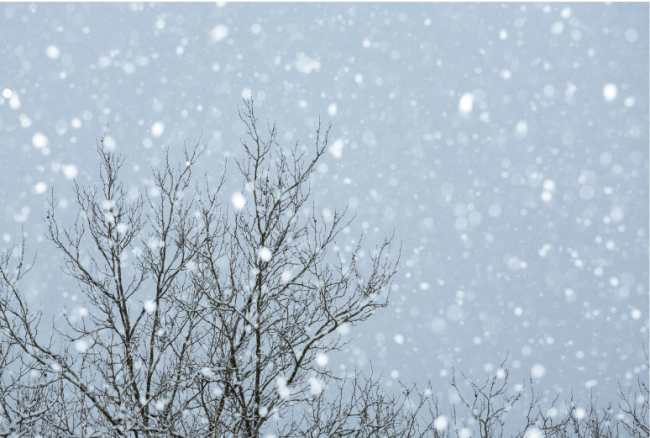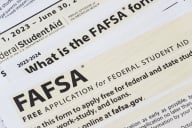You have /5 articles left.
Sign up for a free account or log in.

pixeltouch/Getty Images
As a kid growing up in Michigan and now as a professor teaching at Central Michigan University, I am quite accustomed to snow days. When a snow day falls on a day I teach, I always quietly bemoan the extra work of modifying my syllabi to accommodate the unexpected day off. I wrestle with choices of what to cut and assure myself that if we fail to cover something, everything will be fine.
After a recent snow day, I asked students in my class how they spent their day off. Instead of tales of making a dent in their Netflix queues, playing in the snow or long hours at the recreation center, students complained about the amount of work they did for their classes. This is where I learned of the wide range of their other professors’ expectations regarding cancellations due to snow. Instead of catching up the next time the class met, students shared that their other instructors required them to record reaction videos to the day’s readings; contribute to a discussion board thread, posting one original response and two replies to other posts by midnight; or send the professor an email with takeaways from the readings to earn participation points. Others said their professors held class virtually on Microsoft Teams or WebEx. When I asked how they learned of these expectations, they stated that their instructors emailed them that day.
After class, I searched my university’s website for what to do in the event of a snow day. My institution’s official policy on weather-related closures stipulates that faculty can continue courses “if these functions were previously scheduled for remote instruction.” At the same time, I found several suggestions for faculty to ensure continuity of instruction in the event of a planned or unplanned class cancellation, including uploading materials to our learning management system, recording interactive video lectures, conducting live sessions via WebEx and Teams, creating spontaneous discussion board threads, and developing and deploying online quizzes or assignments.
Perusing other institutional websites revealed a litany of what I soon learned were called “continuity-of-learning plans.” Largely spurred by the COVID-19 pandemic, colleges and universities now offer suggestions, and in many cases clear policies, about instructional continuity during closures. As opportunities for remote instruction accelerated because of the sudden shift to emergency online learning in March 2020, institutions were able to develop multiple options for instructors to continue instruction if meeting in person was not possible. Crafted with good intent, a seldom-realized casualty has been the snow day and the joy that accompanies suspending obligations for a day. The landscape of continuity-of-learning plans is bewildering, sometimes within the same institution.
The University of Nebraska at Lincoln, for example, has two different types of campus closures for inclement weather: an “all classes are canceled” closure seemingly absolving students of class-related responsibilities for the day, and a second “in-person classes are canceled and follow instructional continuity plans.” In the latter closure, students are required to monitor instructor communications for assignments or virtual meeting links. The university also offers customizable guidance to instructors for syllabus language to inform students about their continuity plans. I cannot imagine the confusion these options cause, let alone the range of emotions students face when they learn of a snow day and then remember they have to await their instructors’ communications before making any plans.
One particularly egregious example I noted was from James Madison University, which offers makeup classes on Saturdays, according to the student newspaper. I saw on their institutional Facebook page a question for alumni asking what they remember most about snow days when they were at JMU. I did not scroll through all the comments, but I doubt anyone wistfully remembered Saturday makeup days.
Despite some befuddling examples and a deluge of lengthy instructional practices and policies on institutional websites about weather-related closures, I was heartened to see many institutions, like Marquette University, have severe weather policies prohibiting faculty from mandating “student activities or assignments on a day of closure.” Presumably the logic here is that leaving decisions up to faculty on university closure days creates uneven and difficult experiences for students and faculty alike.
Higher education is not alone in its rush to maintain learning continuity. In an article about the death of snow days in K-12, Andrew Beaujon observed that “the delight of a snow day is in being unexpectedly let out of your obligations due to something completely outside of anyone’s control.” He cautioned against blunting the joys of snow days with continued instruction considering unprecedented stress among young people. He is right. At a time when concerns about mental health and overall wellness for college students are at an all-time high, well-intended efforts to ensure continuity of instruction are at best uninterrogated and at worst foolhardy.
If we set aside the assumption that students are regularly checking their emails on snow days awaiting further instruction, continuity-of-learning plans contain a dangerous assumption that students are appropriately situated to maintain that continuity. Adequate internet and study spaces proved to be an obstacle during the COVID-19 pandemic, with more than half of students stating they lacked an appropriate study space in their homes or were not able to learn effectively online. Additionally, campus closures almost always coincide with K-12 closures, thus forcing students with care responsibilities to adhere to these plans sans childcare. Continuity-of-learning plans for snow days are not only confusing thieves of joy, but they are often at odds with the realities of our students’ complex lives.
Continuity of instruction is undoubtedly important for long-term closures due to climate emergencies or tragedies. But while we are now equipped with an ability to easily push content, assignments and live streams to students on snow days—to paraphrase Jeff Goldblum’s character in Jurassic Park—we never stopped to think if we should.
My plea is for instructors to let snow days be snow days. And if they don’t, the next time they are suddenly released from an obligation, they must resist the temptation to feel the joy washing over them and instead log on to their device to see if a continuity plan was listed for the event. If no such plan is noted, they should await further instructions from the event organizer before settling into anything that brings them respite and perhaps even a little joy.








